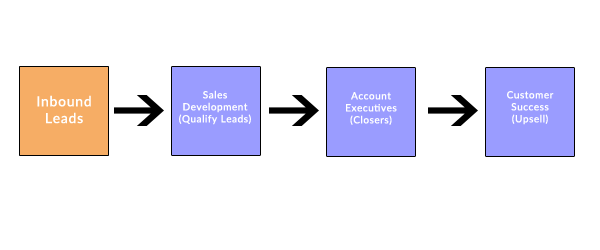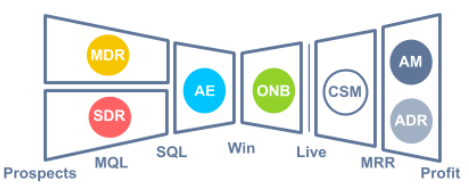You are starting your business, with leads already coming in the pipe. You have hired a few ambitious sales reps but you’re at a loss as to how to much sales team structure is necessary for a successful setup.
There are a few ways to structure your sales organization. First, you can dispatch them according to location. Maybe you have people in the Bay area or covering the Midwest. Schedule some training, sort out a commission scheme, place the location, and away they go.
You have effectively built an island.
Sales Team Structure 1: The Island

You are at the top and each rep is competing with one another for performance in their given vertical or region. They are each responsible for each step of the sales process on their own.
Either, they are provided leads by the marketing team or they have to generate them by themselves through outbound activities. They have to qualify and judge the intent and willingness of the leads. Afterward, a demo will be necessary to show the value of your product and lastly, they arrive at the closing stage. That’s your basic sales workflow that we have discussed in a previous article.
Each sales rep has to rely on their own skills to perform at each step of the funnel. This is a traditional sales operations, such as the one you would find in real estate or financial services.
They have to generate leads by themselves, qualify them, and close them. Reps within this framework tend to be more aggressive. They’ve got their elbows out in fierce competition—not just with the larger market, but their own teams as well. Promotion, call & pitch, and close. Rinse and repeat.
This structure is basic but has proven its effectiveness:
- First, it’s simple and easy to implement with a limited staff
- Second, very little managerial oversight is needed, worst case you can add a mid-level position as a Sales Area Manager when the team size gets bigger
- Third, it encourages competition and independence. Competition can be a good stimulation and with good incentives, get strong performance.
But it can also lead to a degraded work environment:
- In a winner takes all scenario, the sales will fight for the best leads and will tend to be increasingly forceful with their potential customers to try to close the deal.
- Independence can be a bad thing. You lose control over your brand as it’s dependent on the pitch and personality of each sales rep. Each and every one of them is responsible for the whole customer experience.
- As everyone does everything, it can be hard to track performance. Moreover, in the case of a complex sales workflow, sales might not perform well in all areas of sales.
Sales Team Structure Two: The Assembly Line
So we get to the next structure in the list. Maybe there is a way to split the roles? What if we specialize each role? Like Ford during the Industrial Revolution with his famous Model T. Give out a role to each sales rep that they are best at and maximize efficiency.
Let’s conceptualize this. What comes in the work floor are the raw materials, your leads are generated by marketing activities. Sales reps work together on an assembly line to refine the leads into qualified leads. Lastly, assemble the final product, a brand new customer.

To continue with the factory analogy, every sales rep becomes a qualified worker with one of four specializations.
- Inbound/ Lead generation team: Responsible for creating leads out of mailing lists, phone numbers or data. They can work in tandem with the marketing team but they often work with outbound, generating new leads out of a prospecting list.
- Qualifiers/ Sales Development Representatives (SDRs) or Inside Sales: Typically junior members of the team, qualifiers will contact the leads in their pipeline and try to understand the issue affecting the customer. Their goal is to map out all the issues that are relevant to the customer. Who’s the decision maker? How long is the time frame? What challenges are currently facing the potential customer? All this information needs to be correctly filled out so the next person in the process can give the most accurate answers to the lead.
- Closers/ Account Executives (AEs): The deal rests in their hands. More experienced, they have the job of calling the qualified leads, delivering demos and answering the leads’ doubts in order to make the deal move forward and close it. They are your breadwinners.
- Upsell/ Customer Success team: Once closed, new customers are passed on to this team. Their goal is to increase the LifeTime Value (LTV). In the software industry, to do so, they have two objectives: upsell to higher plans or adding new users, thus increasing the Average Revenue per Account. It’s also making sure that the customer doesn’t churn, staying long enough to make up for the upfront cost of having a new customer. In some CS teams, there are split into two smaller teams: the Onboarders who have the goal of welcoming new customers onboard and making sure the implementation runs smoothly and Account Managers who are there to help out customers that have been onboarded but do not make the most of the product.
The assembly line allows for specialization and it has some strong benefits. With a large team size, each step of the sales workflow has a dedicated unit. Each unit can be focused on a metric: number of qualified leads, number of closed deals, etc… These statistics can be of immense help to identify bottlenecks and struggles in your pipeline. Where are leads staying the longest, where are they dropping out? For example, perhaps you have set an overall sales goal of closing 15 deals out of every 100 generated-leads as a conversion rate. If the results say you’re pulling six deals out of every 100, you take a closer look at each step of the funnel to find out where you are losing on potential customers. You might look at your Account Executives and see that they’re closing an acceptable 30% of qualified leads, but your Inside Sales are only managing to qualify 20% of unqualified leads.
Remember Pareto? Make use the 80/20 rule to determine when and where to build new workshops on the assembly line—when your reps spend 20% or more of their time on a secondary role, it might be appropriate to pass that role on to a specialist.
To summarize, let’s see the pros & cons of this model:
Pros:
- More specialization for your sales equals more efficiency in their subrole.
- Dividing the process makes it easy to isolate problems in the funnel, and focus in on them quickly
- It becomes a number game. % of leads becoming qualified leads, then % of leads becoming closed deals and % of deals who churn. The entire process becomes predictable and can be relied on for forecasting.
Cons:
- You need a lot of manpower for this organization. When you have two sales rep, there is no point in splitting out the team. Small teams can make do with the island. Once the volume becomes too high, you need to readjust your sales organization and the assembly line might be one of the solutions.
- By splitting up the funnel into different stages, the lead is passed on to the next team. Information and the issues facing the lead or customer must be kept and passed along. There is nothing more frustrating to a customer than being led on from one person to the next and having to give out the same answers every time.
- Because teams are highly specialized, each team member becomes increasingly disconnected from the overall business goals of the company. This is the same issues plaguing plant managers when they specialize their employees on a specific task. Their workers are focused on their own specific numbers and metrics instead of the bigger picture.
It should be no surprise, that some form of the assembly line model tend to be adopted in most startups at some point or another. You can segment the sales process, refine every aspect of it and ensure predictability. Focus on the stages that don’t perform and you can improve the effectiveness of the whole organization, enabling you to scale fast.
But as we have seen, for people who are the links in the chain, it can be hard to keep focus on the bigger picture. Cohesion and silos are created and employees may find that their impact on the whole organization is fairly limited. To create ownership and accountability, companies, small and large, are making a turn toward customer-centricity. Making sure all positions customer-facing are on the same page and acknowledge each other role is becoming essential. There is no way for a freshly-minted sales executive to know everyone in the organization, from marketing to customer success, but they probably interact frequently with a small team from different backgrounds.
Sales Team Structure Three: The Pod
As such, the pod is an evolution of the assembly line. Instead of being part of a chain of faceless individuals, the pod attempts to establish relations with people from different specializations. Instead of having large teams, you create small pods of specialized roles, and each pod is responsible for the entire journey of specific customers.
For instance, a seven-person sales pod can be responsible for a territory or a country but also along vertical or industry lines. Two of them could be SDRs (or MDRs, for market development rep for inbound leads), providing qualified leads to an Account Executive. To help them keep the customers, an Onboarder and a Customer Success Manager are responsible together for training and the recurring use of the product respectively. An Account Manager handles upsells and an Account Development Representative works on the key account that can be expanded.

Adapt this structure according to your portfolio or industry. If you don’t have many customers yet, you may not need such a high number of Customer Success Managers. You may want to increase the MDR & SDR team size so to ramp up volume. A leaner team structure may be so:

Each pod is responsible for the entire journey of a specific customer from start to finish. We are still using the same roles as in the assembly line. But in this structure, the team knows each other and is accountable for one another to ensure they keep their customers happy. They build stronger and more meaningful relationships and there is no ‘it’s not my responsibility anymore. Hands off’.
In the larger picture, they are also competing with other pods for global performance inside the whole organization. As such, they keep the bigger picture in view and they also can come up with their own ideas independently. Capable of understanding for each role, communication is better, leading to more flexibility and agility.
Seems the best of both worlds, isn’t it?
- Obviously, being a model based on teams, it’s therefore highly dependent of the team cohesion and relations between team members. Conflicts among team members will have a higher impact in this structure than anywhere else.
- For the competitors out there, it’s also a bit more frustrating. There is less opportunity for each sales reps to compete individually, they have to work with the team.
- A tendency that sometimes occurs, is where each member tend to become the “jack-of-all-trades’ answering questions and helping leads or customers at every step, blurring the lines so to speak
Perfect for maturing organizations, it’s the go-to-strategy to tap into new markets and verticals. Pods are independent and are therefore perfectly suitable to go commando and try out new things at a small scale.
But as always, it comes with a tradeoff. What it gains in versatility, it loses efficiency. In a competitive environment facing off with a competitor that has maxed its efficiency with an assembly line model, it’s tough betting on the pods.
Creating a Sales Team Structure Success
As in everything, how you choose the sales team structure at your organization depends on your set of parameters, whether they are markets, goals or business related. Whatever model you choose, you should aim to promote high performance inside the organization. To do so, here are a couple of things to keep in mind if you want to create a sales team that smashes goals.
1. Clearly Define Sales Roles
As mentioned, blurred lines tend to create friction and overlaps. You should make sure every team member understands their roles and responsibilities. This prevents confusion, inefficiencies, and redundancies.
2. Document
In a startup, there is a constant stream of new employees. Document each step of the sales process and map out for them the key stakeholders they are in contact with. This helps keep everyone on the same page.
3. Train and Train Some More
For most people, the issue lies in the lack of training—not a lack of ability. When sales organizations prioritize coaching first and foremost, the whole organization thrives. That is why coaching should be one of the critical functions of any sales manager. Listen to your sales reps’ calls, perform roleplay with them and make sure they understand how the whole process works. It will tremendously help their performance.
To make the most of these team structures, we recommend you use a tool suited to sales teams such as a lead management software. If you are not convinced of their use, why not read our article about the differences between CRM & lead management software and start your free trial today? It might make your life a hell a lot of easier.
Some of the illustrations in this article are provided by Winning by Design, courtesy of Jacco vanderKooij. More information about Pod structure and their implementation can be found on their blog.


